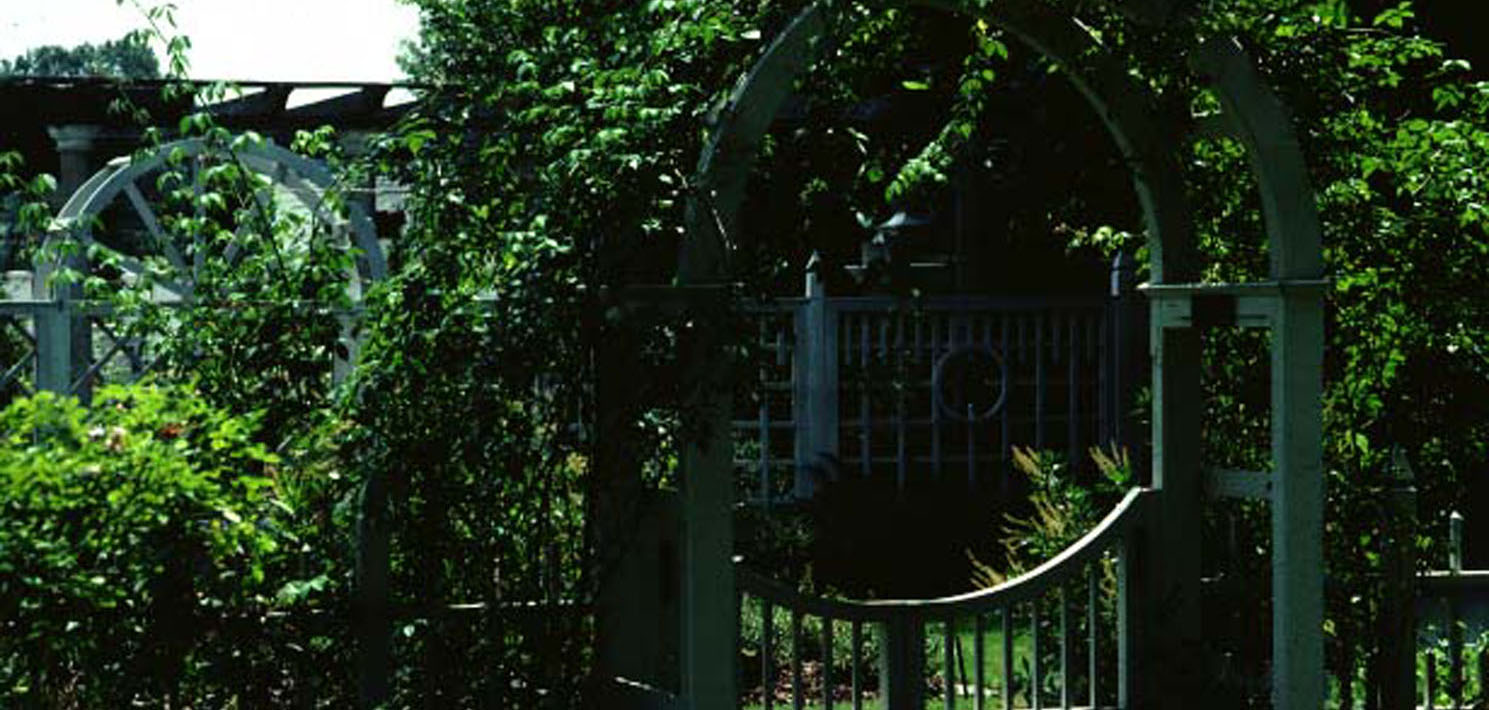Designing with Vines
 Vines serve as an important vertical element in the home landscape. These 'green walls' are used to soften the look of harsh structural items such as masonry and brick, and they can do wonders to improve the appearance of chain link and other types of fences.
Vines serve as an important vertical element in the home landscape. These 'green walls' are used to soften the look of harsh structural items such as masonry and brick, and they can do wonders to improve the appearance of chain link and other types of fences.
Vines growing on the south or west sides of buildings reduce solar heating in the summer, and insulate walls during the winter months. The creative use of vertical structural supports and vines can help to divide areas of the yard into separate spaces, and to screen unsightly views. Finally, vines add a needed splash of color and interest to the seasonal landscape.
Types of Vines
Plants that vine grow vertically by using one of three methods:
1) Aerial rootlets. Clinging vines use small roots along the stem to attach themselves to surfaces, additional supports are not needed. These vines are best utilized on hard surfaces such as masonry or concrete, as their holdfasts can damage wooden surfaces. Boston ivy, trumpet creeper, and Virginia creeper are examples of clinging vines.
2) Twining vines. These vines climb by winding their stems around vertical supports, thus they will need wires, trellises or arbors to properly grow. Depending upon the type of vine, supports need to be sturdy and durable. Large twining vines such as wisteria or rattan vine need ample room and large supports.
3) Vines with tendrils. Tendrils are thin stems that wrap around vertical elements, and will also need structural supports. Muscadine grape and sweet peas are examples of plants that climb with tendrils.
Culture
Container grown woody vines may be planted at any time of the year, but bare-root vines should be planted in spring before new growth begins. New twining or tendril-type plants should be assisted by tying their stems to the support with a soft cloth. Quick growth may be enhanced by applying fertilizer in spring, such as 5-10-5 or similar. Watering may be necessary the first year during dry periods, but most hardy vines will be self-sufficient. Some vines develop sparse foliage near the ground and may need periodic pruning to encourage lower growth.
Selection
Vines should be selected by the intended use, location, soil type, solar exposure and the type of support that will be used. There are evergreen and deciduous vines, as well as annuals (that will need to be replanted each year). When selecting vines, be careful not to choose invasive exotic species that will spread into the landscape such as Japanese climbing fern, Japanese honeysuckle, or cat's claw. Vines offer a wealth of flower colors and bloom times, fragrance, showy fruits, and foliage interest.
The following table lists vines recommended for Mississippi landscapes.
| Scientific Name | Common Name |
|---|---|
| Antigonon leptopus Bignonia capreolata Campsis radicans Clematis species Clematis virginiana Gelsemium sempervirens Ipomoea purpurea Lonicera sempervirens Macfadyena unguis-cati Milletia reticulata Passiflora incarnata Rosa banksiae Smilax lanceolata Trachelospermum jasminoides Vitis species |
Rose of Montana Crossvine Trumpet Vine Clematis Native Clematis Carolina Yellow Jessamine Morning Glory Coral Honeysuckle Cat’s Claw Vine Evergreen Wisteria Maypop Lady Banksia Rose Southern Smilax Confederate Jasmine Grape |
Publications may download photo at 200 d.p.i.
These factsheets were written by Robert F. Brzuszek, Assistant Extension Professor, The Department of Landscape Architecture, Mississippi State University.
Publications
News
An underserved community spent a day enjoying the outdoors at the Sam D. Hamilton Noxubee National Wildlife Refuge in early May as Mississippi State University Extension Service personnel hosted 20 adult residents of care homes.
Jim McAdory, MSU Extension agent in Winston County, coordinated the May 1 event with help from several other Extension agents and U.S. Fish and Wildlife Service staff. The goal was to allow this population to experience the outdoors, complete with a hot dog lunch at the end of the event.
PICAYUNE, Miss. -- School groups, nature enthusiasts and the public can enjoy two fun-filled days of exciting, hands-on learning about the environment, ecosystems, wildlife and insects at the Mississippi State University Crosby Arboretum in Picayune. BugFest offers insect-related displays, interactive exhibits, games and crafts. Biologists, naturalists, entomologists and other experts from Mississippi, Louisiana and Alabama will host booths and give presentations on butterflies, bats, caterpillars, beetles, crayfish, ladybugs, hissing cockroaches, dancing praying mantises, native and exotic arthropods and more.
Two conservation camps this summer offer students in grades six through 12 the opportunity to gain hands-on experience in wildlife science, outdoor recreation and conservation careers. Conservation Camp 2022 has a residential edition June 5-8 for rising eighth through 12th graders. The day camp edition is June 13-15 for rising sixth through eighth graders.
Success Stories
More than 80 grade-school students from Choctaw Tribal Schools visited Mississippi State University in March to participate in Choctaw Preview Day.
Robin Whitfield, who gave the child the paper, stands awestruck, watching her friend’s daughter use the flower to draw and color on the page.
Mississippi State University and partners have been awarded a grant of nearly $6.6 million from the National Fish and Wildlife Federation for shoreline restoration work on the Gulf Coast.




